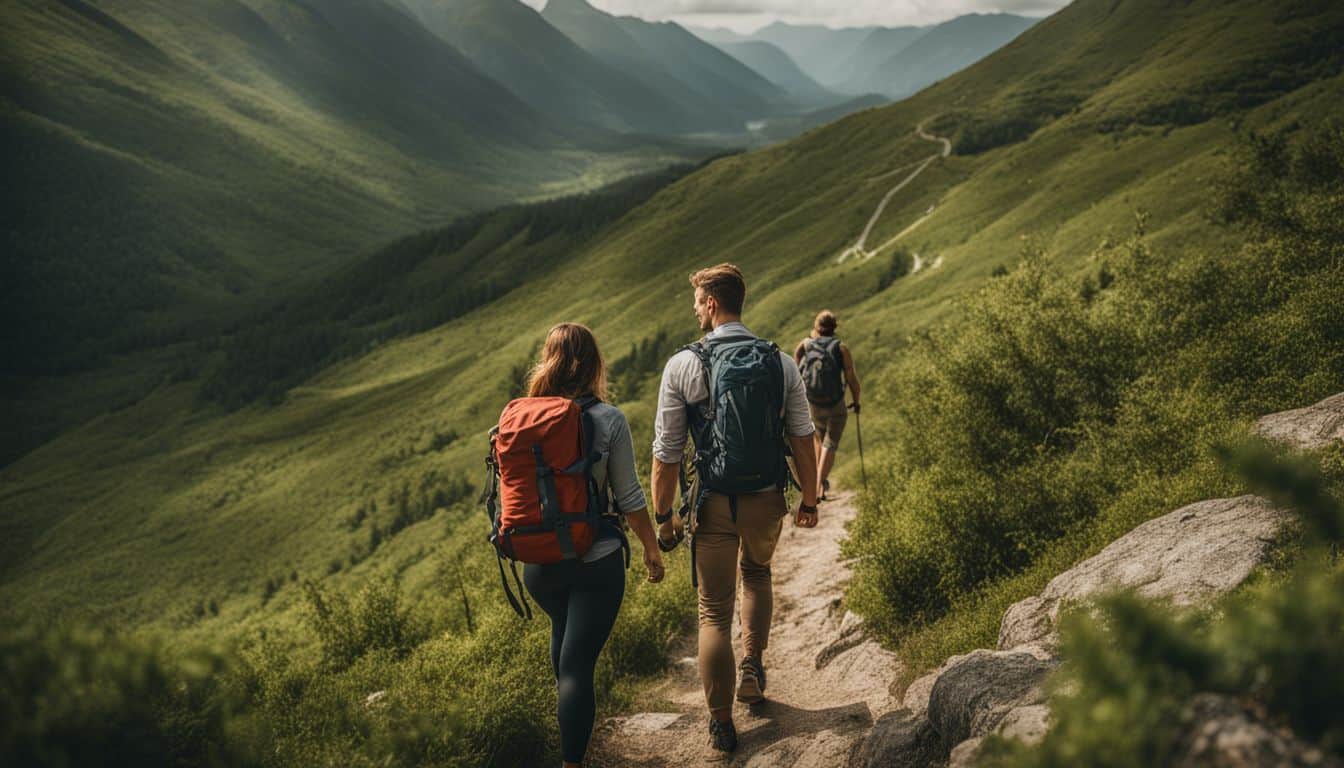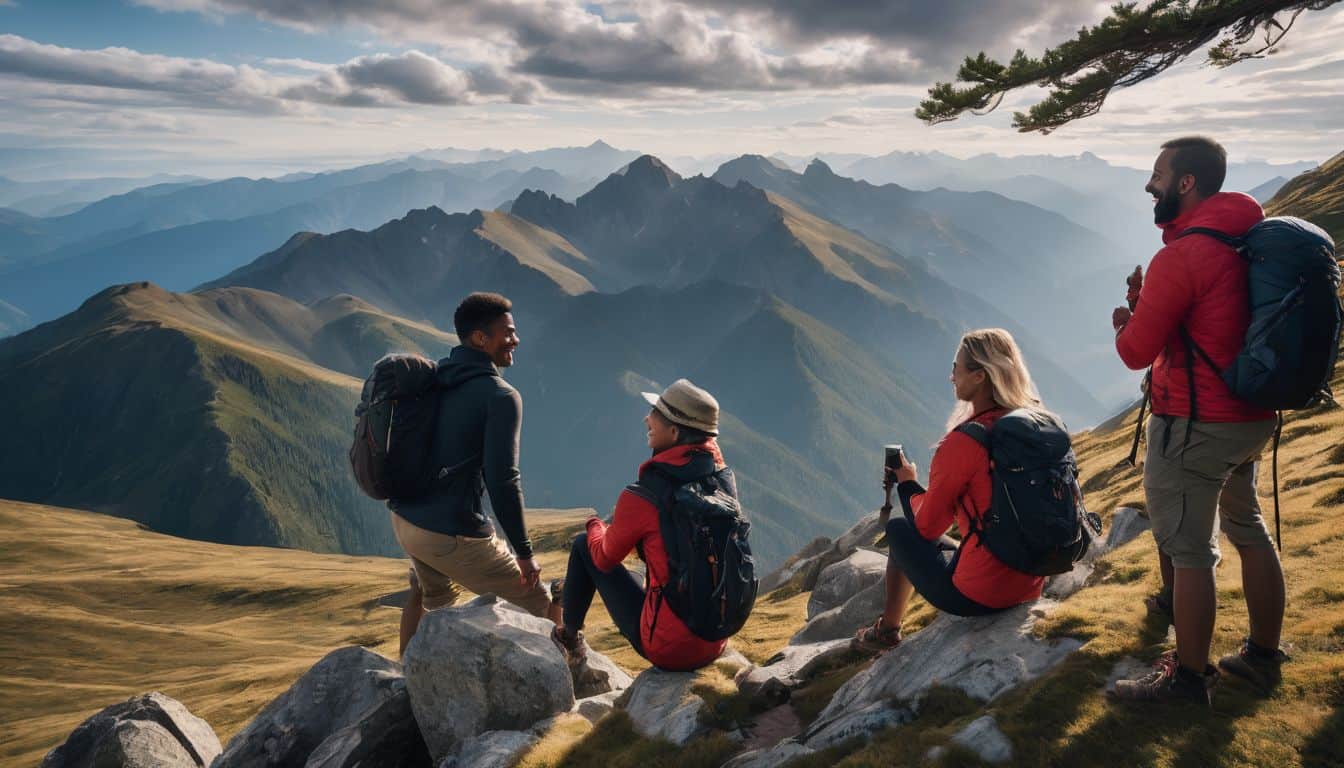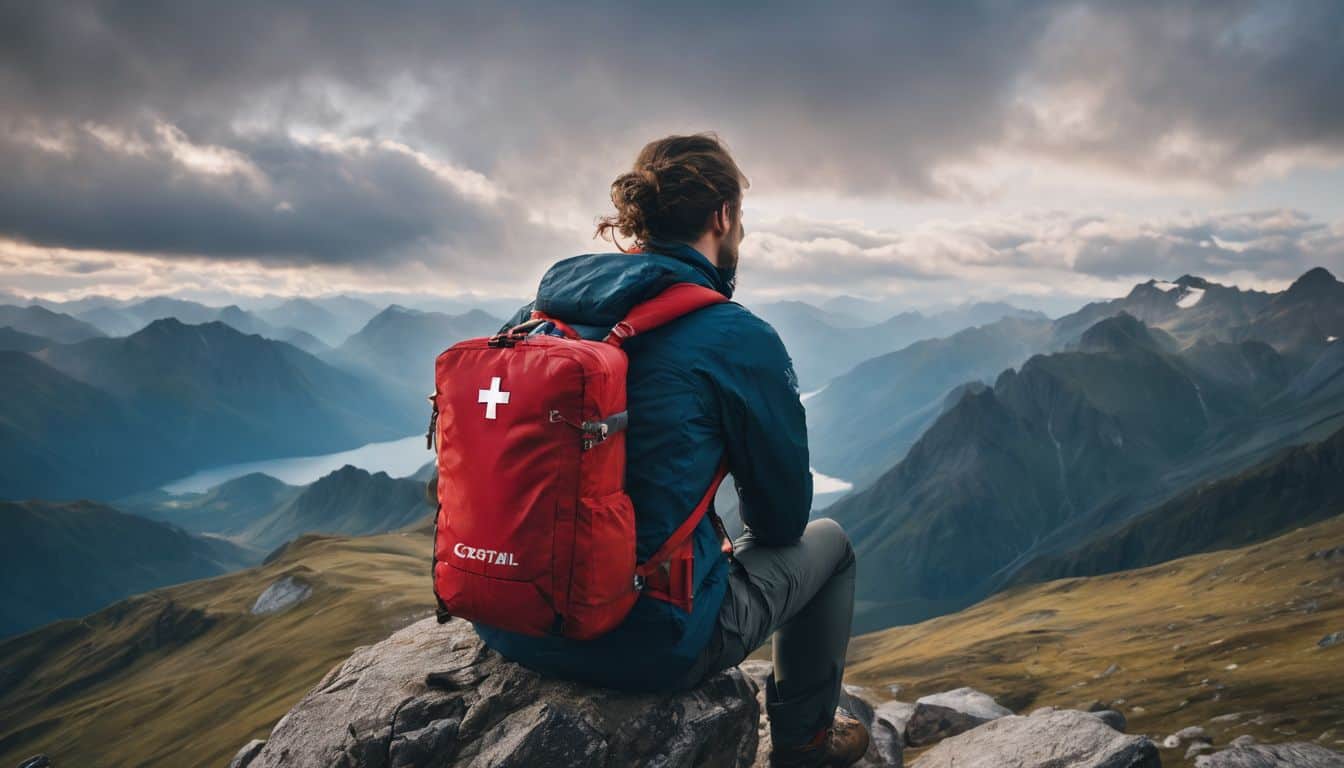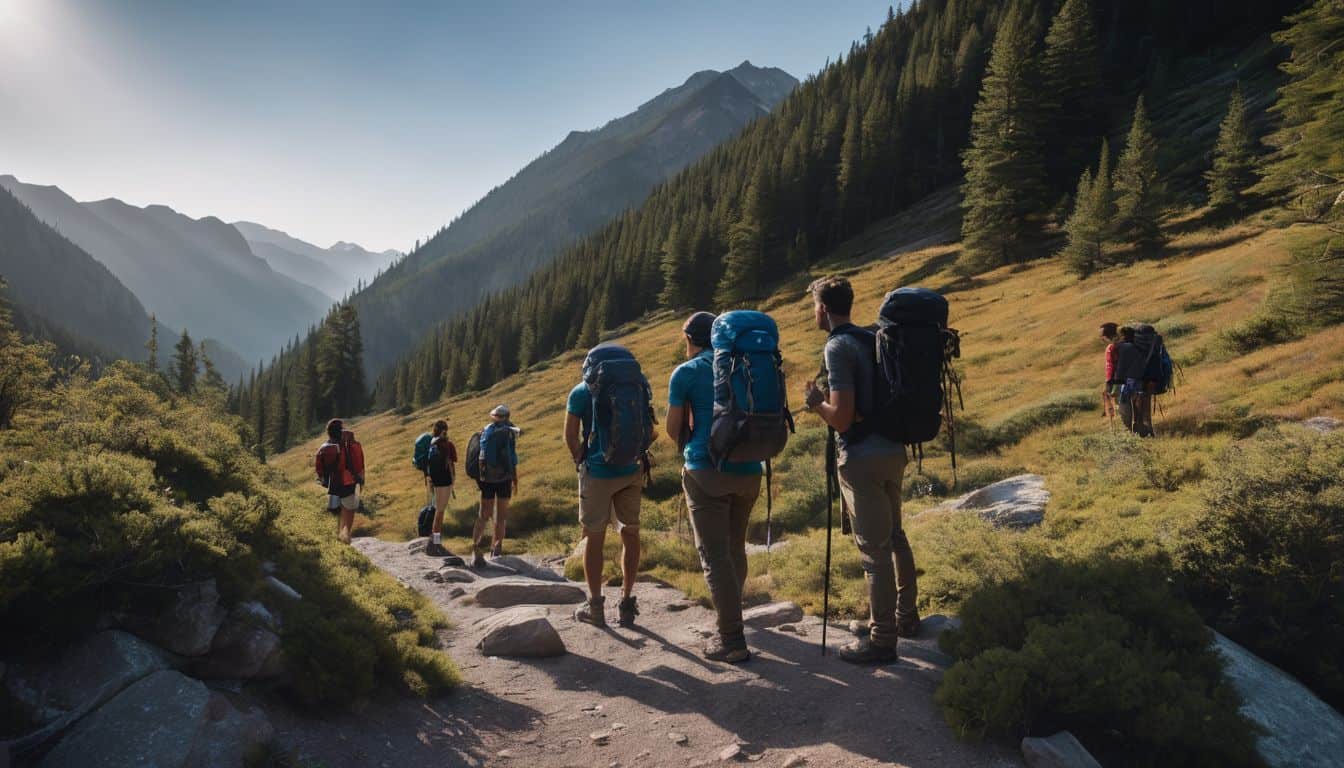I totally understand! Embracing hiking can seem like a daunting task, especially when you’re dealing with health conditions. Believe me, as an enthusiastic hiker who’s juggling her own health concerns, it’s not the easiest route to travel.
But after delving deep into numerous research studies—such as one conducted by Harvard Health that shines light on the benefits of low-impact exercises like hiking for folks with specific health issues—I’m positively buoyed up.
There’s certainly a trail for us all! This blog post is here to guide you on how to safely weave hiking into your everyday life while keeping those pesky health conditions in check, and maybe even leaving them in your dust! So are you ready to lace up those boots and hit the trails? Stick around—we’re about to embark on an exciting journey towards wellness and personal growth together!
Key Takeaways
- Hiking is a great activity for people with specific health conditions. Research shows that low-impact exercises like hiking can be beneficial.
- You don’t have to fit into a specific mold to enjoy hiking. Hiking is about enjoying nature, feeling good in your body, and finding joy in the journey.
- Make hiking part of your routine by hiking often, choosing the right path for you, and taking it one step at a time. Gradual progress is key when considering your health conditions.
- Invest in the right gear for a comfortable and safe hiking experience. This includes getting properly fitted footwear, breaking them in before your hike, choosing the right socks, and bringing essential items like water and food on the trail.
Dispelling Preconceptions About Hiking
Let go of your preconceptions about what it means to be a hiker and embrace the journey ahead.
Give up your preconceptions of what makes a hiker
You don’t have to fit into a box to enjoy hiking. Not all hikers look the same or act the same. Some hike in groups, some go alone. Some like flat trails, while others love steep hills.
You might see a person who looks old but can hike faster than any young person you know! Hiking is not about how much gear you carry or how fast you walk. It’s about enjoying nature and feeling good in your own body.
Commit and enjoy the journey
Hiking is all about joy. It’s a journey, not just to the top of a mountain, but also within yourself. Every step brings growth and shows you things about yourself that stay hidden in daily life.
Each hike fills your heart with happiness from nature’s beauty. The sounds of birds, fresh air, bright sky—it all gives peace to your mind. Hiking isn’t just exercise for the body; it heals your soul too.
The path may be long and tough at times. But that makes reaching the end more special! So smile as you walk each mile. Have fun and treasure every moment on this journey we call hiking.
Making Hiking a Part of Your Routine

Hike often, choose the path you’re on, and take it one step at a time.
Hike often
I make it a habit to hike often. It’s not just something I do on weekends or holidays. The more I walk in nature, the more my body feels good. My mind also becomes clear and calm when I go outside and move around.
Hiking helps me stay fit and keep weight off too! Plus, studies show that hiking lowers the risk of heart problems. For these reasons, regular hikes are part of my lifestyle now! Health benefits aside, getting to look at pretty places while out on trails is always a nice bonus for me as well!
Choose the path you’re on
Making hiking a part of your routine is all about choosing the path that suits you best. Whether it’s a leisurely stroll through nature or an adventurous trek up a challenging trail, find what works for you and stick with it.
Hiking offers numerous benefits for your physical and mental health, so it’s important to choose the path that aligns with your goals and abilities. Take it one step at a time, set achievable goals, and enjoy the journey towards better fitness, stress reduction, and mindfulness in nature.
Take it one step at a time
When it comes to making hiking a part of your routine, it’s important to take it one step at a time. This is especially true if you have specific health conditions. Gradual progress is key in ensuring that you can safely and comfortably enjoy the journey.
Before starting any hike, it’s crucial to assess your fitness level and choose a trail that is beginner-friendly. By taking these steps, you can prepare yourself physically and mentally, ensuring that you have an enjoyable and safe hiking experience while considering your health considerations.
Remember, preparation is key in making hiking a regular part of your routine. Start by assessing your fitness level and finding trails that are suitable for beginners. Take the time to prepare both physically and mentally before each hike so that you can fully enjoy the experience while keeping safety as a priority.
By taking it one step at a time, you’ll be able to gradually build up your stamina and confidence on the trails as well as consider any specific health needs along the way.
The Right Gear
To ensure a comfortable and safe hiking experience, it’s vital to invest in the right gear, including footwear that provides proper support and protection for your feet.
Get the right footwear
Choosing the right footwear is crucial for a successful and enjoyable hiking experience. When it comes to hiking shoes, they are a combination of synthetic/leather boots and trail running shoes.
It’s important to get measured at the end of the day when your feet are largest and most swollen. This ensures that you choose the correct size. There are ten characteristics to consider when selecting hiking shoes or boots: durability, ankle support, traction, waterproofing, breathability, weight, fit, comfort, style preference and price range.
Popular hiking boot brands such as Merrell, Columbia, Keen, and Timberland offer a wide range of options to suit different preferences and needs. So make sure you find the perfect pair of footwear before you hit the trails!
Break in the shoes
Breaking in your hiking shoes is an important step to ensure comfort and prevent foot-related issues on the trail. It allows the leather to soften and for the boots and your feet to conform to each other.
Before your actual hike, it’s recommended to wear your new shoes as much as possible to break them in. Remember, though, that breaking in hiking boots won’t fix a poor fit. So make sure you choose hiking shoes that are comfortable, durable, provide proper padding and support, have good traction, breathability, arch support, and moisture-wicking features for optimal foot health.
You can also waterproof them for added protection against moisture and discomfort. Taking care of your feet is crucial when hiking or backpacking!
Choose the right socks
Choosing the right socks is really important when it comes to hiking. You want to make sure your feet stay comfortable, especially during long hikes. There are a few things you should consider when choosing hiking socks.
First, think about the height of the socks. Some people prefer shorter ankle-length socks, while others like taller crew or knee-high socks for extra protection. Next, look at the cushioning of the socks.
This will help provide some extra comfort and support while you’re on uneven terrain. The fabric of the socks is also important – wool and synthetic materials are best because they wick away moisture and keep your feet dry.
Finally, make sure the fit of the socks is just right – not too tight or loose, and with enough arch support to prevent discomfort or pain after a long hike.
Hiking sock recommendations often include brands like Smartwool, Darn Tough, and Thorlos that offer a variety of options based on different needs such as cushioning level and thickness.

Bring essential items
When hiking with specific health conditions, it is crucial to bring essential items as part of your gear. These items are important for your safety and wellbeing on the trail. The Ten Essentials should always be included in your pack, which includes food and water to keep you energized and hydrated throughout the hike.
Proper clothing is necessary to protect you from the elements, while proper footwear will provide support and prevent injuries. Additionally, don’t forget about protective equipment like a whistle or flashlight in case of emergencies.
It’s also important to consider special equipment and expert knowledge of mountain conditions if hiking in winter. So remember, when going on a hike with specific health conditions, don’t underestimate the importance of bringing these essential items along with you.
Have a hiking-specific pack
When hiking with specific health conditions, it’s important to have a hiking-specific pack. This means choosing a backpack that is designed for hiking and has the right features and capacity for your needs.
Look for a pack that fits you properly and distributes weight evenly to avoid strain or discomfort. A well-fitted pack will help prevent back pain and make your hike more enjoyable.
Remember to bring all the essential items you need for a safe and successful hike, such as water, food, navigation tools, a first aid kit, and extra clothing layers. By having a hiking-specific pack, you’ll be prepared and ready to tackle any trail with confidence.
Preparing for Your Hike
Before you hit the trail, it’s important to take a few key steps to ensure a safe and enjoyable hike: check with your doctor, choose the right trail for your fitness level and health condition, let someone know where you’re going, check the weather forecast, and make sure to wear appropriate clothing for the conditions.
Check with your doctor
Before you start hiking, it’s important to check with your doctor, especially if you have any specific health conditions. This is to ensure that you are physically ready for the activity and that it won’t pose any risks to your well-being.
Your doctor can provide valuable advice and guidance based on your personal health assessment, fitness level, and medical history. By consulting with your physician, you can make sure that hiking is a safe and enjoyable experience for you.
Always prioritize safety first!
Choose the right trail
When it comes to hiking, it’s important to choose the right trail that suits your abilities and health conditions. Before starting a hike, make sure to assess your physical condition and know your limits.
For first-time hikers, consider picking a trail that is suitable for beginners and has moderate difficulty level. It’s also essential to prepare for the hike by checking the weather forecast, wearing appropriate clothing, and bringing necessary gear such as water, food, map or compass, flashlight or headlamp, whistle, and cellphone.
Remember to let someone know where you’re going before heading out on the trail. By choosing the right trail and preparing properly, you can have an enjoyable and safe hiking experience.
Tell someone where you’re going
I always make sure to tell someone where I’m going before I head out for a hike. It’s an important safety precaution, especially if you have specific health conditions. By informing a friend or family member about your hike plans, you create a safety net for yourself.
In case of an emergency, they will know where to find you and can quickly get help if needed. Not only does this provide peace of mind for both you and your loved ones, but it also ensures that someone is aware of your whereabouts in case something goes wrong.
Remember to leave a note with hike details at home or in your car as an additional precautionary measure. Safety should always be our top priority when exploring the great outdoors!
Check the forecast
Before starting your hike, it’s important to check the forecast. This helps you plan your hike based on the weather conditions. You can avoid dangerous situations like extreme heat or storms by staying updated with the weather report.
It also allows you to prepare for different temperatures and potential weather concerns during your hike. If you’re hiking in colder months, keep in mind that there may be winter-related health risks to consider as well.
So, always make sure to check the forecast before hitting the trail!
Wear the right clothing
Choosing the right clothing is crucial for a comfortable and safe hiking experience. When you’re out on the trail, it’s important to wear appropriate attire that protects you from various elements.
Opt for breathable fabrics like moisture-wicking clothing to keep sweat away from your body and prevent overheating. Light-colored clothing, such as white or tan, reflects sunlight and helps keep you cool in hot weather.
Additionally, long sleeves and pants are recommended for brushy woodlands or forested areas to protect your skin from scratches and insect bites. Layering your clothes allows you to adjust to changing weather conditions easily, ensuring that you stay warm or cool depending on the situation.
Hiking With Specific Health Conditions: A Comprehensive Guide
When hiking with specific health conditions, it’s important to be prepared and take extra precautions. First, consult with your doctor to ensure that hiking is safe for you. They can provide guidance on any limitations or modifications you may need to make.
Choose a trail that matches your fitness level and consider the terrain and elevation changes. It’s also essential to bring any necessary medications or medical devices with you, such as an inhaler or glucose monitor.
Take breaks when needed and listen to your body if you start feeling unwell. Stay hydrated and fuel your body with nutritious snacks along the way. Finally, hike with a buddy or let someone know where you’ll be in case of an emergency.
Remember, hiking can be a great way to improve both physical and mental health, but always prioritize safety first.
Tips for Staying Safe
Bring essential items such as water, food, a cellphone, a map or compass, a whistle, a headlamp, and a flashlight. Follow the Leave No Trace principles and stay on trails while being aware of your surroundings.
Hike in a group for added safety. To discover more tips on staying safe during hikes with specific health conditions, keep reading!
Bring water, food, a cellphone, a map or compass, a whistle, a headlamp, and a flashlight
When I go hiking, it’s important for me to bring some essential items to ensure my safety. First and foremost, I always carry enough water to stay hydrated throughout the hike. It’s also crucial to have some food with me in case I need a boost of energy during the trek.
Another item that I never forget is my cellphone, which serves as my lifeline in case of emergencies or if I need help navigating the trail. To prevent getting lost, having a map or compass is essential for keeping myself on track.
Additionally, a whistle can be really handy for attracting attention or signaling for help if something goes wrong. Finally, carrying a headlamp and flashlight allows me to see clearly even when it gets dark outside.
Follow the Leave No Trace principles
When hiking with specific health conditions, it’s important to follow the Leave No Trace principles. These principles provide guidelines for responsible outdoor recreation and help minimize our impact on the environment.
One important principle is to always stay on the trail and travel on durable surfaces. This helps avoid damage to ecosystems and preserves natural resources. It’s also essential to concentrate use on existing trails and campsites, rather than creating new ones.
By following these principles, we can ensure that future hikers can enjoy the outdoors just as much as we do while keeping our surroundings pristine and beautiful.
Stay on trails and be aware of your surroundings
It’s important to stay on designated trails and be aware of your surroundings while hiking. This helps ensure your safety and protects the environment. By staying on trails, you avoid damaging plants, rocks, and other natural features.
It also helps you navigate more easily without getting lost. Being aware of your surroundings means paying attention to any potential hazards, such as unstable terrain or wildlife.
Keep an eye out for trail markers or signs that indicate where the trail leads. By following these guidelines, you can have a safe and enjoyable hiking experience.
Hike in a group
Hiking in a group is important for staying safe and enjoying your hike. Being part of a group provides additional support and assistance in case of emergencies or health issues. It can help boost your confidence and provide a sense of security while hiking, especially if you have specific health conditions.
When you hike with others, you can share resources like food, water, and equipment, which can be helpful if you need extra assistance. Additionally, having people around increases the likelihood of someone being available to provide medical aid if needed.
Furthermore, hiking in a group can also provide emotional support and motivation to keep going and stay active. So grab some friends or join a hiking club – it’s more fun and safer to hike together!
Benefits of Hiking
Hiking offers the opportunity to enjoy the warmth of the weather, reduce arthritis and joint pain, boost bone density, and improve cardiovascular health.
Enjoy the warmth of the weather
I love hiking in warm weather because it allows me to enjoy the beautiful outdoors and soak up some sunshine. Not only is it a great way to explore nature, but it also has so many health benefits.
When you hike in warm weather, you are getting physical exercise that can help with weight loss and improve your cardiovascular health. Plus, being outside in the warmth can boost your mood and reduce stress.
Did you know that hiking in warm weather can even lower your blood pressure and reduce the risk of heart disease? So why not take advantage of the nice weather and head out for a hike? It’s a fun and enjoyable way to stay active while enjoying the beauty around us!
Reduce arthritis, knee, and joint pain; boost bone density
Hiking is a fantastic way to reduce arthritis, knee, and joint pain while also boosting bone density. Regular hiking can help alleviate the discomfort caused by these conditions and improve overall joint health.
By engaging in weight-bearing exercise like hiking, you strengthen your bones and muscles, which is particularly beneficial for those with osteoporosis. Hiking also stimulates calcium retention in the bones, slowing down the rate of calcium loss.
So get out there on the trails and enjoy the many benefits that hiking has to offer!
Improve cardiovascular health
Hiking is a fantastic way to improve cardiovascular health. It gets your heart pumping and strengthens your heart muscles, which can lower the risk of cardiovascular disease. Regular hiking can also help prevent chronic illnesses like cancer and type 2 diabetes.
Plus, it’s an affordable outdoor exercise that you can easily incorporate into your routine. By hiking regularly, you’ll be able to enjoy the benefits of improved endurance, reduced risk factors for heart disease, and overall better cardiovascular fitness.
So get out there on the trails and start reaping these amazing health rewards!
Using Apps and Resources
Discover the best hiking apps, read helpful reviews, and find essential resources to enhance your hiking experience. Ready to take your hikes to the next level? Click here to learn more.
Download useful apps
If you love hiking like I do, you’ll be excited to know that there are some really useful apps available for download in 2023. These apps can make your hiking experience even more enjoyable and help keep you safe along the way.
One app that I highly recommend is AllTrails. It has a wide range of features, including GPS tracking, detailed maps, and trail reviews from other outdoor enthusiasts. This can be really helpful when you’re trying to find new trails to explore or if you want to see what others have said about a particular hike.
Additionally, there are also free walking apps like MapMyWalk GPS and Fitbit App Mobile Tracker that can be used for hiking as well. So go ahead and give these apps a try – they’re like having a personal guide right in your pocket!
Read reviews
I always make sure to read reviews before using any hiking apps or resources. It’s important to know what other hikers have experienced and if the app or resource is reliable. Reviews can give you insights into the usability, features, and overall satisfaction of other hikers.
They can also help you determine if a particular app or resource is suitable for your specific needs and preferences. By reading reviews, I can make more informed decisions about which apps and resources will enhance my hiking experience.
So, it’s definitely worth taking the time to check out what others have to say before diving in.
Get resources
Finding resources for hiking is easier than ever with the help of online platforms and mobile applications. These tools can assist you in locating hiking trails in your area or nearby regions, making it convenient to plan your next outdoor adventure.
By using these resources, you can easily find information about trail difficulty, length, and scenic views. Additionally, you can read reviews from other hikers to get a better sense of what to expect on the trail.
With these helpful apps and websites available at your fingertips, you’ll be able to organize your hikes efficiently and ensure that you have all the necessary gear and safety measures in place for a pleasurable trekking experience.
Making Hiking Inclusive
Addressing underrepresentation in certain communities, discussing the need for management-level changes, and providing actionable steps for hikers to make the outdoors more inclusive.
How certain communities are underrepresented
Certain communities, like people of color, families with children, and low-income communities, are often underrepresented in the hiking and outdoor activities. This is due to historic discrimination and lack of access to resources.
People of color may have experienced exclusion or unwelcomeness in outdoor spaces, which has deterred them from engaging in outdoor recreation. Additionally, families with children may face barriers such as limited time or financial constraints that prevent them from participating in hiking activities.
Low-income communities may also lack access to green spaces and hiking trails close to their neighborhoods. It is important for the hiking community to recognize these disparities and work towards creating a more inclusive environment where everyone feels welcome on the trails.
What needs to be done on a management level
To create a more inclusive hiking community, we need to take action on a management level. This means promoting diversity and inclusivity by cultivating a welcoming and respectful environment for hikers of all races and abilities.
It’s important for hike organizers to effectively communicate hike details such as difficulty level, length, terrain, and necessary equipment so that everyone can make informed decisions about participating.
Additionally, addressing assumptions and stereotypes based on race or disability is crucial in creating a supportive atmosphere for hikers of diverse backgrounds. By providing equal opportunities for all individuals to engage in hiking activities and fostering a sense of belonging and acceptance, we can make the outdoors truly inclusive for everyone.
What hikers can do to make outdoors inclusive
As hikers, we have the power to make the outdoors a more inclusive space for everyone. One important thing we can do is to promote diversity and representation in hiking communities.
We should actively encourage people from all backgrounds and abilities to join us on our adventures. By fostering a welcoming environment and embracing different perspectives, we can create a culture of acceptance in hiking groups.
It’s also crucial that we educate ourselves on adapting trails for different abilities and advocating for equal access to hiking opportunities. Together, let’s work towards making the great outdoors accessible and enjoyable for everyone.
Conclusion on Hiking With Specific Health Conditions
In conclusion, hiking can be a wonderful activity for people with specific health conditions. By following these 7 tips for growth, such as choosing the right gear and preparing properly, you can safely enjoy the benefits of hiking while taking care of your health.
Don’t let any preconceptions hold you back – start hiking today and experience the joy of being in nature while improving your overall well-being.
FAQs on Hiking With Specific Health Conditions
1. Is it safe for me to go hiking if I have a health condition?
It is important to consult with your healthcare provider before going hiking if you have a health condition, as they can provide personalized advice based on your specific situation.
2. Are there any precautions I should take before hiking with a health condition?
Before hiking with a health condition, make sure to inform someone about your plans, carry necessary medications or medical supplies, wear appropriate footwear and clothing, and start with shorter and easier trails.
3. What are some common health conditions that may affect hiking?
Some common health conditions that may affect hiking include heart problems, respiratory issues, joint or muscle pain, diabetes, allergies, and high blood pressure. However, this is not an exhaustive list; each individual’s situation varies.
4. Can I hike alone if I have a specific health condition?
It is generally recommended to hike with a companion if you have a specific health condition so that there is someone who can assist you in case of an emergency or worsening of symptoms.
5. How can I prepare physically for hiking with my specific health condition?
To prepare physically for hiking with your specific health condition, engage in regular exercise appropriate for your fitness level and gradually build up endurance over time. Additionally, follow any recommendations from your healthcare provider regarding physical activity and lifestyle modifications.





Leave a Reply